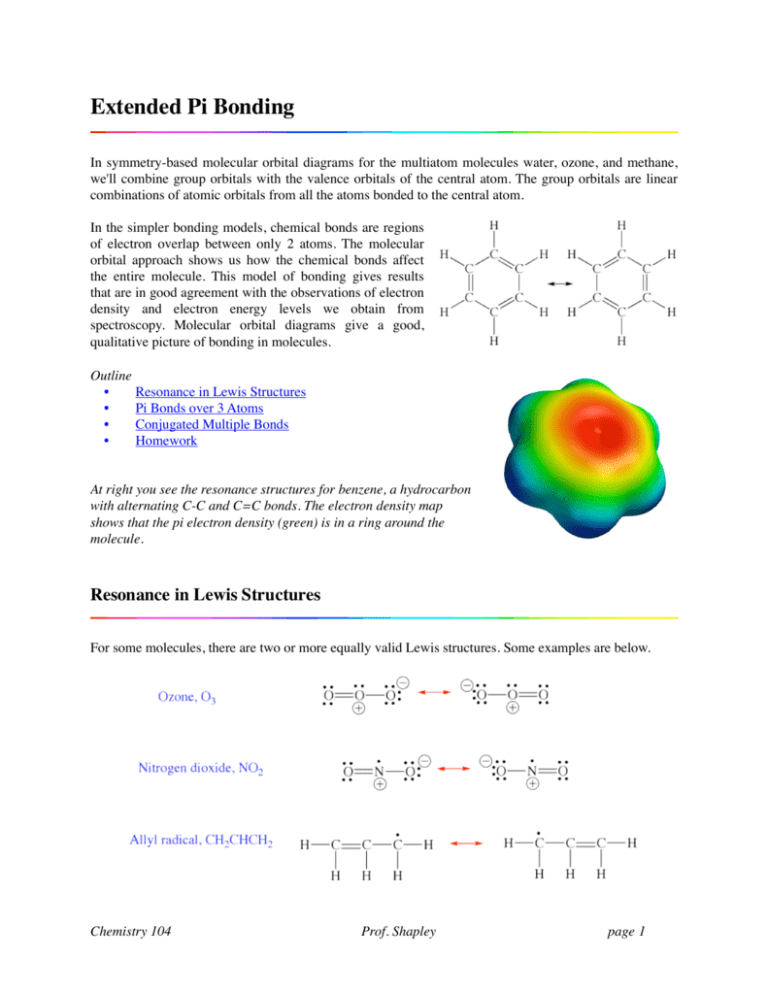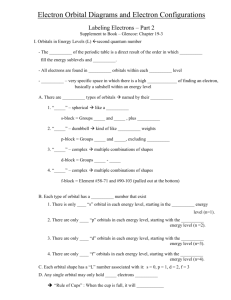Extended Pi Bonding
advertisement

Extended Pi Bonding In symmetry-based molecular orbital diagrams for the multiatom molecules water, ozone, and methane, we'll combine group orbitals with the valence orbitals of the central atom. The group orbitals are linear combinations of atomic orbitals from all the atoms bonded to the central atom. In the simpler bonding models, chemical bonds are regions of electron overlap between only 2 atoms. The molecular orbital approach shows us how the chemical bonds affect the entire molecule. This model of bonding gives results that are in good agreement with the observations of electron density and electron energy levels we obtain from spectroscopy. Molecular orbital diagrams give a good, qualitative picture of bonding in molecules. Outline • Resonance in Lewis Structures • Pi Bonds over 3 Atoms • Conjugated Multiple Bonds • Homework At right you see the resonance structures for benzene, a hydrocarbon with alternating C-C and C=C bonds. The electron density map shows that the pi electron density (green) is in a ring around the molecule. Resonance in Lewis Structures For some molecules, there are two or more equally valid Lewis structures. Some examples are below. Chemistry 104 Prof. Shapley page 1 When there are two equivalent Lewis structures, the bonding of the molecule is likely to be an average of the two. Think about the molecular orbital diagram of each of these molecules. After forming sigma bonding and sigma antibonding orbitals, three contiguous atoms have a remaining p orbital. These p orbitals are pointing in the same direction, let's call that the x direction. The Lewis structures show a double bond between either the first 2 atoms or the second 2 atoms. The two structures differ only in the pi bonding. Can we illustrate pi bonding that extends over 3 or more atoms in a molecular orbital diagram? First, consider the hybridization of the oxygen atoms in ozone. After forming the sigma bonds with the 2sp2 hybrid orbitals between the atoms, each oxygen atom has a remaining 2p orbital for pi bonding. Pi Bonds over 3 Atoms Chemistry 104 Prof. Shapley page 2 Ozone Let's look at the molecular orbital diagram of ozone. We'll use the hybrid orbital approximation. Each oxygen atom combines its 2s, 2pz and 2py orbitals to make three 2sp2 hybrid orbitals. • O1 uses one 2sp2 orbital to combine with one 2p2 orbital of O2, making a sigma bonding and sigma antibonding orbital • O3 uses one 2sp2 orbital to combine with a second 2sp2 orbital of O2, making another sigma bonding and sigma antibonding orbital • Two 2sp2 orbitals on O1, one 2sp2 orbital on O2, and two 2sp2 orbitals on O3 are non-bonding. The 2px orbital on O1, the 2px orbital on O2, and 2px orbital on O3 combine to form three pi symmetry orbitals. The p orbitals in the picture above indicate electron density in those orbitals. • π1, bonding all the way across the 3 atoms • π2, non-bonding, zero pi electron density on the second atom • π3, antibonding, the mathematical sign of the wavefunction changes with every atom, repulsive interaction between atoms The full molecular orbital diagram with the electrons is below. Chemistry 104 Prof. Shapley page 3 Nitrogen Dioxide Nitrogen dioxide has one fewer electron than ozone. Because of this, the highest energy orbital that is occupied by electrons, the π2 orbital, has only one electron. At right are the molecular orbitals for nitrogen dioxide. The nitrogen atom is less electronegative than the oxygen atoms so its atomic orbitals are a little higher in energy. Because one of the non-bonding orbitals is localized on the N atom, it is a little higher in energy than the four non-bonding orbitals localized on the two oxygen atoms. Because there is one 2px orbital on each atom available for pi bonding, there are three pi symmetry molecular orbitals. Each oxygen atom contributes is 6 valence electrons and the nitrogen contributes 5 electrons. The total, 11 electrons, fills orbitals from low energy to higher energy. The π2 orbital has only 1 electron. Chemistry 104 Prof. Shapley page 4 Allyl Radical In CH2CHCH2, 5 of the carbon 2sp2 hybrid orbitals combine with the 5 hydrogen 1s orbitals to form 5 C-H σ bonding orbitals and 5 C-H σ antibonding orbitals. These levels are colored blue in the figure. The remaining four carbon 2sp2 hybrid orbitals (one each on the end carbons and two on the middle carbon) combine to form 2 C-C σ bonding orbitals and 2 C-C σ antibonding orbitals. These levels are black in the figure. The 2px orbitals (one from each carbon atom) combine to form the three pi orbitals. These are green in the figure. There are a total of 17 electrons, 4 from each carbon and 1 from each hydrogen atom. Conjugated Multiple Bonds When each adjacent atom in a row of have a p orbital with the same orientation, a px orbital for example, the p orbitals will combine to make pi orbitals that extend over all those atoms. The atoms in such a set have a conjugated pi system. For a conjugated set of n atoms: 1. n atomic p orbitals forms a set of n pi symmetry molecular orbitals 2. average energy of the pi molecular orbitals equals the average energy of the p orbitals 3. as n increases, the energy difference between the pi molecular orbitals decreases Chemistry 104 Prof. Shapley page 5 Why is this important? When molecules contain pi bonding orbitals, the highest occupied molecular orbital (HOMO) and the lowest unoccupied molecular orbital (LUMO) are typically pi symmetry molecular orbitals. Molecules are colored when they absorb visible light. In unsaturated molecules, an electron is promoted from one pi orbital to another. The difference in energy between these orbitals determines the wavelength of light that the molecule can absorb. Chemistry 104 Prof. Shapley page 6 The molecules in the table above are all colorless. The energy between the HOMO and LUMO pi orbitals is above the visible light region. They absorb light in the shorter wavelength ultraviolet region of the spectrum. The beta-carotene molecule, with 26 interacting p orbitals, does absorb visible light. You've seen that ozone acts as a bleach, converting the orange molecule to a colorless one. This is because it breaks the pi system. Instead of 26 interacting p orbitals with an energy gap in the visible region, there is a 14 p orbital unit and a 10 p orbital unit. These pi systems have a HOMO-LUMO energy gap in the ultraviolet. Chemistry 104 Prof. Shapley page 7







